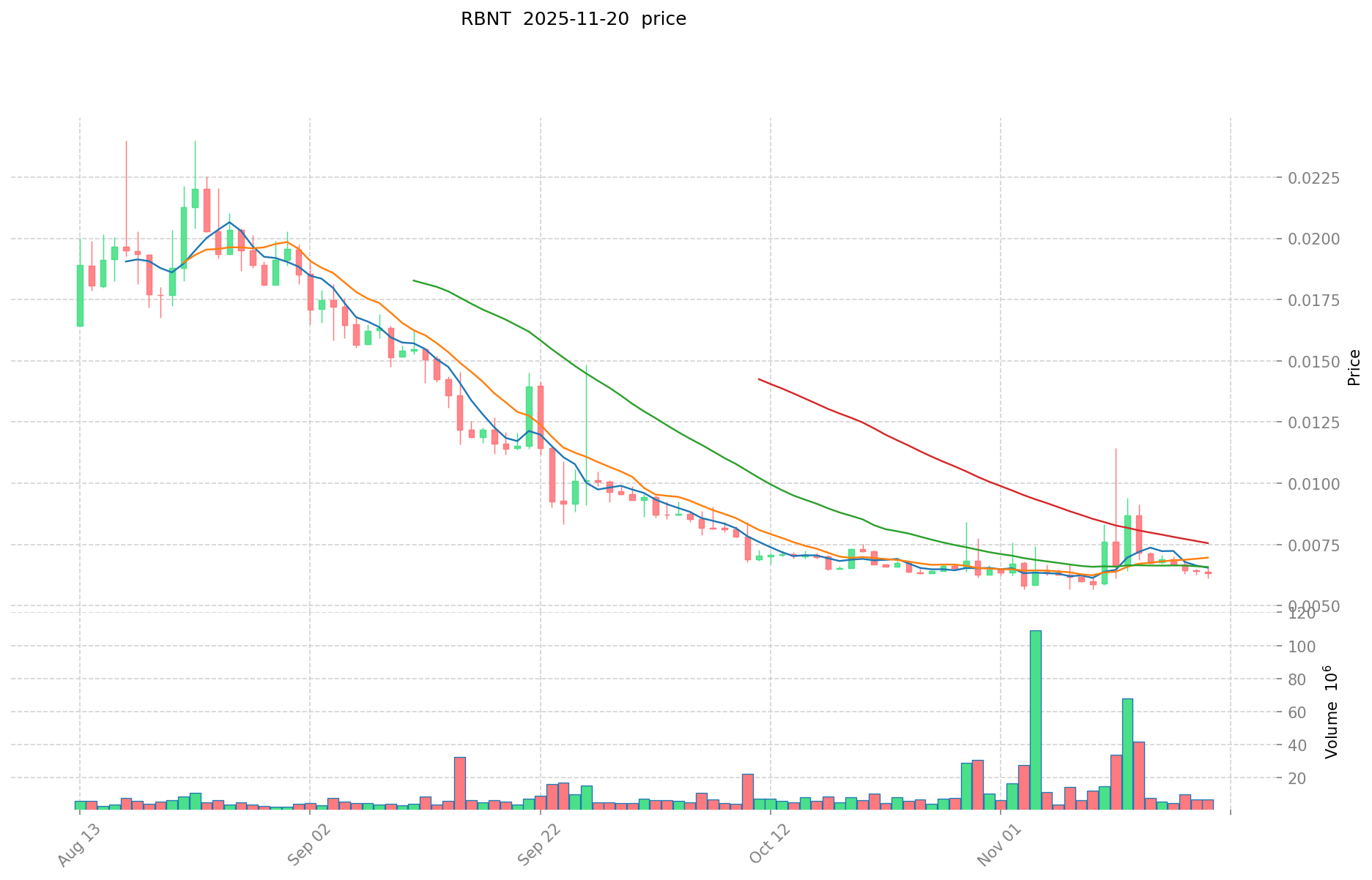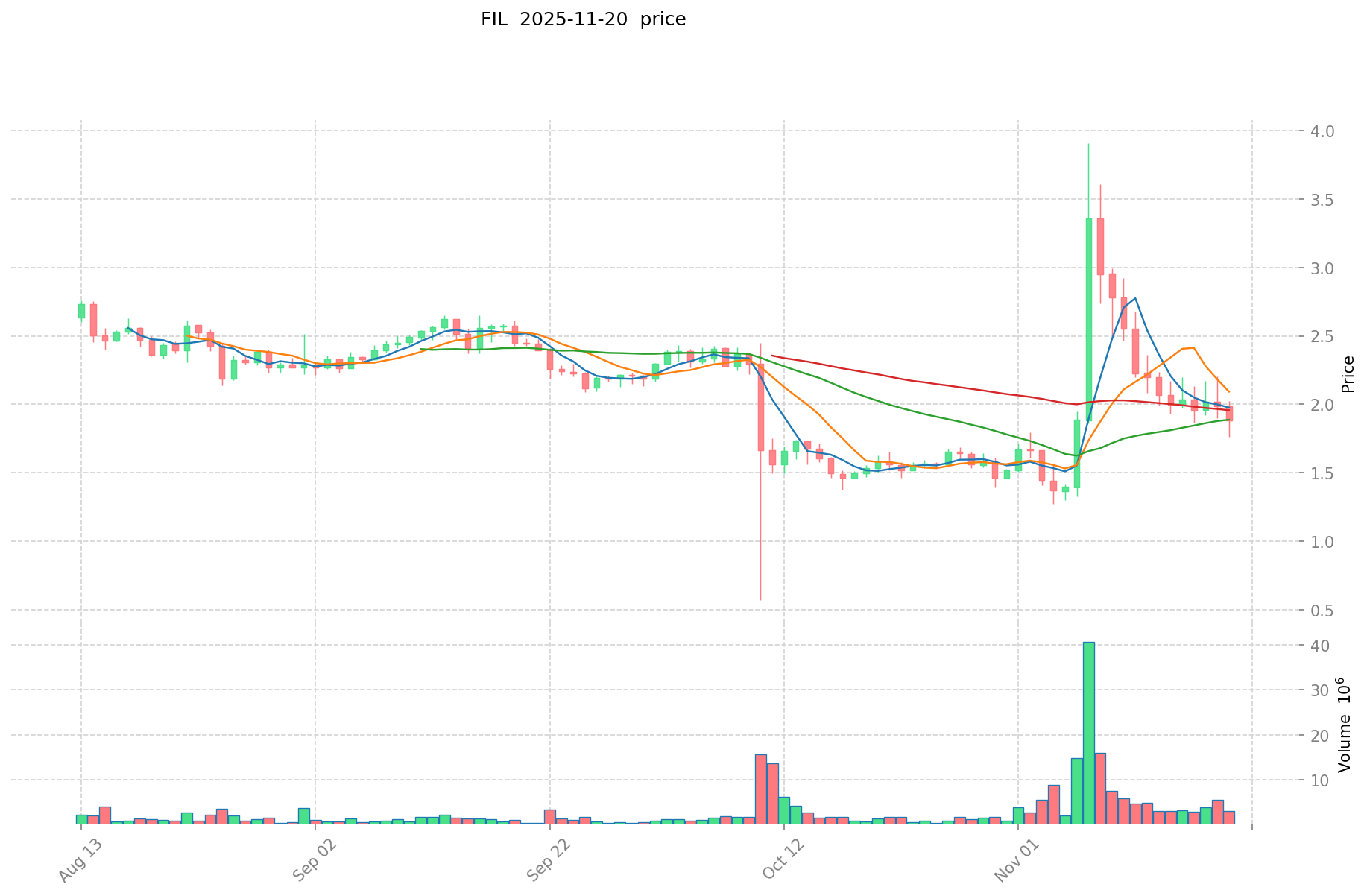RBNT vs FIL: Comparing Two Innovative Blockchain Technologies for Data Storage Solutions
Introduction: Investment Comparison between RBNT and FIL
In the cryptocurrency market, the comparison between Redbelly (RBNT) vs Filecoin (FIL) has been an unavoidable topic for investors. The two not only show significant differences in market cap ranking, application scenarios, and price performance, but also represent different positioning in the crypto asset landscape.
Redbelly (RBNT): Since its launch, it has gained market recognition for being the world's first formally verified blockchain developed in collaboration with leading Australian research institutions.
Filecoin (FIL): Introduced in 2017, it has been hailed as a decentralized storage solution, becoming one of the most prominent cryptocurrencies in terms of global trading volume and market capitalization.
This article will provide a comprehensive analysis of the investment value comparison between RBNT and FIL, focusing on historical price trends, supply mechanisms, institutional adoption, technological ecosystems, and future predictions, aiming to answer the question most concerning to investors:
"Which is the better buy right now?"
I. Price History Comparison and Current Market Status
RBNT and FIL Historical Price Trends
- 2024: RBNT reached its all-time high of $0.449 on December 29, 2024.
- 2025: RBNT hit its all-time low of $0.005652 on November 3, 2025, showing significant price volatility.
- Comparative analysis: In this market cycle, RBNT experienced a dramatic decline from $0.449 to $0.005652, while FIL's historical high of $236.84 occurred much earlier in April 2021.
Current Market Situation (2025-11-20)
- RBNT current price: $0.006294
- FIL current price: $1.87
- 24-hour trading volume: RBNT $38,104.41 vs FIL $3,827,362.49
- Market Sentiment Index (Fear & Greed Index): 11 (Extreme Fear)
Click to view real-time prices:
- View RBNT current price Market Price
- View FIL current price Market Price
II. Project Overview and Technological Comparison
RBNT (Redbelly Network)
- Background: Developed by the University of Sydney in collaboration with CSIRO and the Australian National Science Agency.
- Key features: World's first formally verified blockchain, enabling digital asset registries and structured financial products.
- Target: Focuses on asset issuers with established network effects, promoting accountability and clean liquidity.
FIL (Filecoin)
- Background: A decentralized storage network built on IPFS.
- Key features: Rewards miners for contributing idle hard disk space using a proof-of-workload algorithm.
- Target: Aims to create a decentralized market for data storage and retrieval.
Technological Comparison
- Consensus mechanism: RBNT uses a formally verified blockchain, while FIL employs proof-of-workload.
- Use case focus: RBNT targets digital asset registries and financial products, FIL focuses on decentralized storage.
- Development stage: RBNT is relatively new, while FIL has been in operation since 2020.
III. Market Performance Analysis
Market Capitalization and Ranking
- RBNT: Market cap of $15,387,195, ranked 1027th
- FIL: Market cap of $1,345,758,188, ranked 70th
Price Trends (as of 2025-11-20)
- RBNT:
- 24h: -2.41%
- 7d: -12.57%
- 30d: -5.92%
- 1y: -97.74%
- FIL:
- 24h: +2.46%
- 7d: -15.86%
- 30d: +22.50%
- 1y: -57.83%
Trading Volume and Liquidity
- RBNT: 24h volume of $38,104.41
- FIL: 24h volume of $3,827,362.49
- Analysis: FIL shows significantly higher trading volume and liquidity compared to RBNT.
IV. Investment Considerations
Potential Risks
- RBNT:
- New project with limited market history
- High volatility, as evidenced by recent price swings
- Lower liquidity and trading volume
- FIL:
- Competitive market for decentralized storage solutions
- Significant price decline from all-time high
Potential Opportunities
- RBNT:
- Innovative approach to digital asset registries
- Collaboration with established research institutions
- FIL:
- Established player in decentralized storage
- Recent positive price momentum in the 30-day timeframe
Key Factors to Monitor
- Adoption rates of RBNT's digital registry solutions
- FIL's market share in the decentralized storage sector
- Regulatory developments affecting blockchain and digital assets
- Overall market sentiment and cryptocurrency adoption trends
V. Conclusion
RBNT and FIL represent different segments within the blockchain ecosystem. RBNT, as a newer project, offers innovative solutions for digital asset registries but faces challenges in terms of market adoption and liquidity. FIL, while more established, has shown significant price volatility but maintains a strong position in the decentralized storage market. Investors should carefully consider the distinct risk profiles and potential opportunities of each project in the context of their investment strategies and market conditions.


II. Core Factors Affecting Investment Value of RBNT vs FIL
Supply Mechanisms Comparison (Tokenomics)
- RBNT: Fixed supply of 51 million tokens with scheduled unlocking periods
- FIL: Inflationary model with block rewards that decrease over time
- 📌 Historical pattern: Supply constraints in RBNT create potential scarcity value, while FIL's more inflationary model has shown price pressure during unlock events.
Institutional Adoption and Market Applications
- Institutional holdings: FIL has gained more institutional adoption through Grayscale's Filecoin Trust and other investment vehicles
- Enterprise adoption: FIL has established partnerships with major tech companies for decentralized storage solutions, while RBNT remains focused on niche DeFi applications
- Regulatory attitudes: Both tokens face varying regulatory treatment across jurisdictions, with FIL generally experiencing broader regulatory acceptance
Technical Development and Ecosystem Building
- RBNT technical upgrades: Implementation of Moonstone upgrade to enhance the Ribbon Finance ecosystem
- FIL technical development: Network upgrades focused on storage efficiency and retrieval speed improvements
- Ecosystem comparison: FIL has a more developed ecosystem for decentralized storage with real-world applications, while RBNT focuses on structured DeFi products with options and derivatives
Macroeconomic Factors and Market Cycles
- Performance during inflation: FIL has positioned itself as "digital real estate" with utility value during inflationary periods
- Macroeconomic monetary policy: Both tokens show sensitivity to interest rate changes and dollar strength
- Geopolitical factors: FIL's decentralized storage proposition may benefit from increasing data sovereignty concerns globally
III. 2025-2030 Price Prediction: RBNT vs FIL
Short-term Prediction (2025)
- RBNT: Conservative $0.00609-$0.00628 | Optimistic $0.00628-$0.00779
- FIL: Conservative $1.74-$1.87 | Optimistic $1.87-$2.06
Mid-term Prediction (2027)
- RBNT may enter a growth phase, with expected prices ranging $0.00488-$0.01076
- FIL may enter a consolidation phase, with expected prices ranging $1.39-$2.75
- Key drivers: Institutional capital inflow, ETF, ecosystem development
Long-term Prediction (2030)
- RBNT: Base scenario $0.01041-$0.01081 | Optimistic scenario $0.01081-$0.01135
- FIL: Base scenario $3.81-$4.07 | Optimistic scenario $4.07-$4.31
Disclaimer: The above predictions are based on historical data and market analysis. Cryptocurrency markets are highly volatile and subject to rapid changes. This information should not be considered as financial advice. Always conduct your own research before making investment decisions.
RBNT:
| 年份 | 预测最高价 | 预测平均价格 | 预测最低价 | 涨跌幅 |
|---|---|---|---|---|
| 2025 | 0.00778844 | 0.006281 | 0.00609257 | 0 |
| 2026 | 0.0082306224 | 0.00703472 | 0.0040097904 | 11 |
| 2027 | 0.010762066392 | 0.0076326712 | 0.004884909568 | 21 |
| 2028 | 0.01131276361908 | 0.009197368796 | 0.0078177634766 | 46 |
| 2029 | 0.010562718193766 | 0.01025506620754 | 0.008819356938484 | 62 |
| 2030 | 0.011345692498711 | 0.010408892200653 | 0.009680269746607 | 65 |
FIL:
| 年份 | 预测最高价 | 预测平均价格 | 预测最低价 | 涨跌幅 |
|---|---|---|---|---|
| 2025 | 2.0581 | 1.871 | 1.74003 | 0 |
| 2026 | 2.907534 | 1.96455 | 1.5912855 | 5 |
| 2027 | 2.75272746 | 2.436042 | 1.38854394 | 30 |
| 2028 | 3.6580824693 | 2.59438473 | 1.6344623799 | 38 |
| 2029 | 4.501776383496 | 3.12623359965 | 2.50098687972 | 67 |
| 2030 | 4.30982564047749 | 3.814004991573 | 2.09770274536515 | 103 |
IV. Investment Strategy Comparison: RBNT vs FIL
Long-term vs Short-term Investment Strategies
- RBNT: Suitable for investors focused on innovative DeFi solutions and digital asset registries
- FIL: Suitable for investors interested in decentralized storage and data management potential
Risk Management and Asset Allocation
- Conservative investors: RBNT: 5% vs FIL: 15%
- Aggressive investors: RBNT: 15% vs FIL: 30%
- Hedging tools: Stablecoin allocation, options, cross-currency portfolios
V. Potential Risk Comparison
Market Risk
- RBNT: High volatility due to low market cap and limited trading history
- FIL: Susceptible to fluctuations in the broader decentralized storage market
Technical Risk
- RBNT: Scalability, network stability
- FIL: Mining power concentration, security vulnerabilities
Regulatory Risk
- Global regulatory policies may impact both differently, with FIL potentially facing more scrutiny due to its storage-focused nature
VI. Conclusion: Which Is the Better Buy?
📌 Investment Value Summary:
- RBNT advantages: Innovative approach to digital asset registries, collaboration with established research institutions
- FIL advantages: Established player in decentralized storage, broader institutional adoption
✅ Investment Advice:
- New investors: Consider a small allocation to FIL for exposure to decentralized storage sector
- Experienced investors: Balanced approach with both RBNT and FIL, adjusting based on risk tolerance
- Institutional investors: Focus on FIL for its more established market presence and ecosystem
⚠️ Risk Warning: The cryptocurrency market is highly volatile, and this article does not constitute investment advice. None
VII. FAQ
Q1: What are the key differences between RBNT and FIL? A: RBNT is a newer project focused on digital asset registries and structured financial products, while FIL is an established player in decentralized storage. RBNT has a fixed supply of 51 million tokens, while FIL has an inflationary model. FIL has higher market cap, trading volume, and institutional adoption compared to RBNT.
Q2: Which token has shown better price performance recently? A: As of November 20, 2025, FIL has shown better recent performance. In the 30-day timeframe, FIL has gained 22.50%, while RBNT has declined by 5.92%. However, both tokens have experienced significant losses over the past year.
Q3: What are the main risks associated with investing in RBNT and FIL? A: For RBNT, main risks include high volatility, limited market history, and lower liquidity. For FIL, risks involve competition in the decentralized storage market and significant price decline from its all-time high. Both face regulatory risks, with FIL potentially facing more scrutiny due to its storage-focused nature.
Q4: How do the supply mechanisms of RBNT and FIL compare? A: RBNT has a fixed supply of 51 million tokens with scheduled unlocking periods, potentially creating scarcity value. FIL has an inflationary model with block rewards that decrease over time, which has shown to create price pressure during unlock events.
Q5: What are the long-term price predictions for RBNT and FIL? A: By 2030, the base scenario predicts RBNT to be in the range of $0.01041-$0.01081, while FIL is expected to be in the range of $3.81-$4.07. However, these predictions are subject to market volatility and should not be considered as financial advice.
Q6: How do institutional adoption and market applications differ between RBNT and FIL? A: FIL has gained more institutional adoption through vehicles like Grayscale's Filecoin Trust and has established partnerships with major tech companies for decentralized storage solutions. RBNT remains focused on niche DeFi applications and has less institutional presence currently.
Q7: Which token might be more suitable for different types of investors? A: New investors might consider a small allocation to FIL for exposure to the decentralized storage sector. Experienced investors could take a balanced approach with both RBNT and FIL. Institutional investors may focus more on FIL due to its more established market presence and ecosystem.
Share
Content